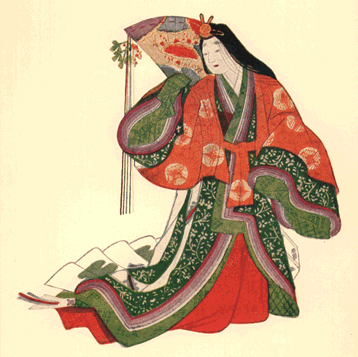Movement to “Heian-kyo”
- known today as Kyoto, capital of Japan from 794 until 1868

- Abandoning the Chinese
- Sent no further missions to China
- severed continental contact = increasing independence, adaptation
The City of Heian-kyo
- Rectangular
- about 2 1/2 miles across from west to east and about 3 1/2 miles long from north to south.
- A stone wall about 6 foot high with a 9 foot ditch on both sides surrounded the city.
- The city had two rivers running at its edges: the Kamo on the east side and the Katsura on the west side
- Beyond the rivers, mountains ring the city on the east, north and west sides.
- 5 million people. Of these, probably 50 thousand lived in Heian Kyo.
- Development of Writing
- Kanji:
- used by men in Heian period
- Chinese characters
- difficult to learn
- Hiragana
- used by women during the Heian period
- alphabet still used today
Our Resources: Women Writers
- Lady Murasaki Shikibu
- The Tale of Genji/ Tale of the Shining Prince
- Depicts Heian aristocratic life
- Sei Shonagon
- Author of the Pillow Book
- The Cult of Beauty
- Aesthetic sensibility and emotional depth-> show of aristocracy and ranking
- Poetry, calligraphy, music, perfume, dress
- Japanese Houses
- The Pillow Book (do not copy)
- “A preacher should be good-looking. For, if we are properly to understand the worthy sentiments of his sermon, we must keep our eyes fixed on him while he speaks; by looking away we may forget to listen. Accordingly an ugly preacher may well be the of sin . . . .” (Shonagon 106)
Keeping Up Appearances
- men and women wore heavy, light coloured make-up (small goatee for men)
- both sexes: make-up coloured part of the lips since small mouths (and eyes) were a sign of beauty
- Women
- Plucked eyebrows and painted new ones higher up
- rouged their cheeks and tiny mouths
- dyed their teeth black
- hair parted in the middle, unadorned, flowed to the ground
The Cult of Beauty
- Costumes
- Men:
- Wore stiff black cap, patterned, waist-length robe with voluminous sleeves over billowing trousers -> whole outfit in shades of white, brown, or black
- Costumes
- Women:
- Long silken robes -> colourful and patterned (Sometimes wore as many as 12 of these robes, one on top of the other).
- Each robe had shorter sleeves than the one beneath, so a rainbow of colours flashed when the arms moved
The Heian Court
- Preoccupation with art, etiquette, literature, costume, language-> lost touch with reality
Meanwhile, in the real world…
- Power Structure Changing:
- Provincial warrior’s power increasing (the early samurai).
- Increase of private landownership -> made powerful families more powerful (by 10th century no more public land allotments)
- Court growing increasingly removed from provinces in their charge (sending court-appointed governors)
- Central control weakened
- Loss of Power Within the Court
Emperor’s loss of personal power
- The use of Regents
- Fujiwara family
- Family provided empresses
- Enthronement of young emperors (born of Fujiwara mothers)
- older men in family able to declare themselves regents
- Early abdication
- Young emperor controlled by abdicated emperor (rather than a regent)
- Way of combating Fujiwara regents
Minor nobles vying for power
- Formed armed guards -> bushi (warriors) and samurai (retainers)
- Grew powerful by making alliances
- Became powerful enough to intervene in the central court
